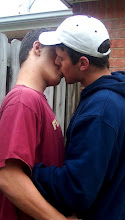
The closet is Hell, but the movies speak to you. You saw Rebel without a Cause several times, while necking with the projectionist guy. Everyone raves about James Dean as Jim, but you know better. Sal Mineo as Plato is the real rebel. He keeps trying to get Jim alone at the abandoned mansion. Plato is like you and your handsome movie theatre boy. It's like a secret fraternity. We have our own codes and symbols.
The magazines also speak to you. You frequent the local newsstand. There among the confession and science fiction glossies are the Holy of Holies: the fitness and physique magazines. You buy them one by one, along with newspapers to hide them, so as not to arouse suspicion and horrible reactions like, "You goddamn, fucking queer!"
You collect Vim, Your Physique, Tomorrow's Man, Body Beautiful, Physique Pictorial, and others. They cost next to nothing. One is 35 cents; another is maybe 50. You take them home, choose your favorite Greek gods, and jerk off in ritual worship of their sacred images.
The magazines feature photography studio ads! You order more beefcake pictures. They thankfully arrive in plain envelopes. You have more semi-naked athletes, cowboys, sailors, lumberjacks, and Roman soldiers to add to your collection. You jack off all the more, when you can't be with your boyfriend.
The pictures make life bearable in this bland, repressive, and dangerous time. Mark One is one of your favorite mail order sources. The envelopes come from Lachine, a city near Montréal. The photographer dares not speak his name. You understand why. A man can get arrested for "crimes against nature." For you, his is the unknowable, unspeakable name of God.
You don't know Alan Bentley Stone. He fell into beefcake photography through an unlikely source. Stone grew up in the Boy Scouts of Canada. When he began his photography business, he naturally took pictures for some Scouting publications. To illustrate some exercises, he photographed bodybuilder Billy Hill, a former Scout. Stone suddenly saw a lucrative future beyond that contract.
World War II has ended, and interest in bodybuilding is growing. This has led to an explosion of muscle mags, and homosexuals like you represent the majority of their readers. You don't know Stone's name, but through the years, you love his pinup boys: Martin Reid, Gilles Leonard, Steve Belding, Mike Mangione, Gérald Desfossés, and many others.
You don't know that Stone suffers from arthritis, but in spite of his disease, he becomes one of the most successful beefcake photographers in Canada during the 50s and 60s. You don't know what becomes of him. You don't know the sacred mystery --until now.

In 2006, Amérimage-Spectra produced the 49 minute documentary Eye on the Guy: Alan B. Stone and the Age of Beefcake. It features an audiotaped interview of Stone, as well as his pictures and home movies of his models.
It also includes commentary from fellow artist Peter Flinsh, anthropologist Ross Higgins, former curator Jean-François Larose, bodybuilding entrepreneur Ben Weider, and Concordia University (Montréal) cinema professor Dr. Tom Waugh. The documentary was directed by Philip Lewis and Jean-François Monette.
The documentary DVD is sold by the Archives gaies du Québec (Gay Archives of Québec), where Stone's photo collection is now preserved. Even though the Archives website advertises the DVD, you cannot buy it online. You have to order it by mail. Talk about retro.
Just send a $30 check ($25 for the DVD plus $5 shipping and handling) to this address:
Gay Archives of Québec
4067 Boulevard St. Laurent #202
Montréal, Québec
H2W 1Y7 Canada
Include your name, address, the DVD title (Eye on the Guy: Alan B. Stone and the Age of Beefcake), and which language you prefer: the French version or the "English/International" version.
Before Calvin Klein popularized homoerotic images in the 80s, Stone and his fellow photographers advertised their hugely profitable mail order businesses in the beefcake magazines under the guise of art, health, fitness, and historical reenactments. Many pictures seem dated now. The posing straps that some models wore look especially obsolete, but they were required by law. They couldn't show their dicks or pubic hair.
However, there's still a timelessness to Stone's work. Many of his pictures are minimalist in style: Just the models, ma'am. Unlike other photographers, Stone wasn't big on props --maybe a chair here or a rope there. He also wasn't keen on sets. He photographed men in junkyards, bare studios, abandoned houses, and natural settings. This is in contrast to Bob Mizer's models, who are sometimes upstaged by woefully outdated Hollywood sets and costumes.
Alan B. Stone was a Canadian Scout made good, and he's starting to gain a new following through vintage beefcake websites. He died in 1992, but his photos have clearly outlived the magazines that first published them. As the United States catches up to Canada's more progressive attitudes about homosexuality, it's high time we celebrate the iconic beauty of his pictures.
You're legal now. They can't disapprove. You and Stone's boys no longer have to live in the shadows.
Photo Credits:
Car Boy 1 -- Alan B. Stone;
James Dean (left) and Sal Mineo 2 -- Rebel without a Cause. Dir.
Nicolas Ray. Warner Bros. Pictures, 1955;
Newsstand 3 -- Alan B. Stone, 1951;
Mike Mangione 4 -- Alan B. Stone;
Alan B. Stone 5 -- Unknown photographer;
Billy Hill 6 -- Alan B. Stone;
Martin Reid 7 -- Alan B. Stone;
Eye on the Guy ad 8 -- Studio oneonone design of
Amérimage-Spectra documentary (2006) information
superimposed on Mike Mangione by Alan B. Stone (1962);
Gérald Desfossés and Mike Mangione 9 -- Alan B. Stone;
Physique Illustrated covers 10 -- Keith Fisk (left, April 1963) and
Mike Mangione (September, no year) by Alan B. Stone;
Cliff D'Arrow 11 -- Alan B. Stone.














+(Just+Beautiful+Men).jpg)